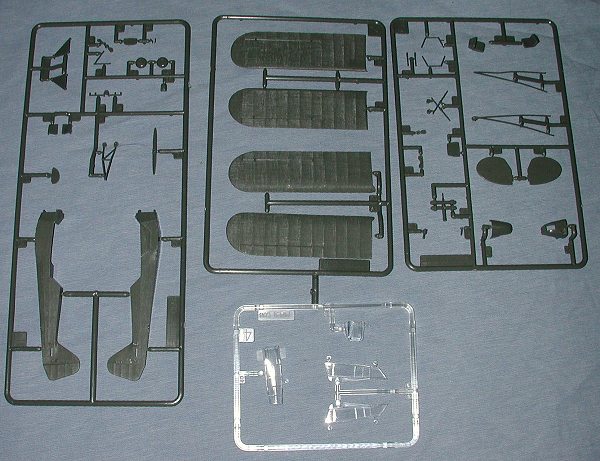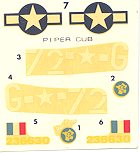
|
KIT: |
Heller 1/50 L-4 Cub |
|
KIT # |
400 |
|
PRICE: |
$ Long OOP |
|
DECALS: |
One aircraft |
|
REVIEW & |
|
|
NOTES: |
` |

|
HISTORY |
When I was a kid, there was an airport behind my home. It wasn't anything fancy, just a grass strip, but it was home for about a dozen aircraft. The fellow that lived next to it had a son my age in school and he also owned a bright yellow 1939 Piper Cub. One day, he asked me if I'd like to go for a ride in it. Well, needless to say, I jumped at the chance. Revving up the 50 or so horses in the four-banger Continental, the plane bounced along the strip and was soon in the air. Zooming along at full bore and about 65 mph, I saw my small world from the air and had the chance to fly the plane a short time. This was the first time I had ever been in a light plane and it was quite an experience. Back then, a light plane could be bought for $2-3,000 dollars, a rather princely sum in 1960 when a good annual wage was around $6-8,000 a year. Well, things have changed. The grass strip is now closed because of urban sprawl. A light plane runs over $100,000 and a good annual wage is $40,000 (which is a heck of a lot more than I have ever earned in a year!).
However, the light aircraft performed a number of duties for all forces in WWII. The US used it for artillery spotting and general battlefield reconnaissance. It was also used to haul the brass around as it was able to operate from cow pastures near the troops. The story of these planes and the pilots who flew them is one that you rarely hear about. They didn't go 350 mph, they had no guns other than a .45 or Tommy gun carried by the pilot or passenger, and they got no air to air kills. However, they were just as important to the war effort was were the more exotic types.
|
THE KIT |

This is one of Heller's older kits. Heller followed the lead of Tamiya in the 1960s and developed a line of kits in 1/50 scale. In fact, they did a number of light planes and helicopters in this scale. Unfortunately, it turned out that it wasn't the scale of the future as 1/48 quickly took over as the medium scale of choice. However, a 1/50 kit is not that far from 1/48 and they often cannot be told from the larger brethren. As you might expect from a kit of this era, the panel lines are all engraved and the fabric surfaces a bit overstated, but really not that bad. A bit of sanding will cure that.
A nice option is a complete engine. If you wish to display your Cub with the covers off, you can. A bit of extra detailing will also go a long way to help. The interior is complete with seats, controls and instrument panel. What you may want to add are some plastic rod to duplicate the welded steel frame that you see when you get in the plane.
 The instructions are
of the exploded view type with no direct construction sequence. However, with a
kit of this type it is more than adequate. They color callouts are in French,
but basically the plane is just about all olive drab with a few parts in black
and aluminum. The small decal sheet is for one aircraft seconded to the free
French forces. As old as it is, it is very badly yellowed so will need to be
replaced. Not really a problem as the spares box should hold all you need.
Besides, I have always thought that Heller decals were made yellow as that is
the way most of mine have been!
The instructions are
of the exploded view type with no direct construction sequence. However, with a
kit of this type it is more than adequate. They color callouts are in French,
but basically the plane is just about all olive drab with a few parts in black
and aluminum. The small decal sheet is for one aircraft seconded to the free
French forces. As old as it is, it is very badly yellowed so will need to be
replaced. Not really a problem as the spares box should hold all you need.
Besides, I have always thought that Heller decals were made yellow as that is
the way most of mine have been!
If you are into light planes at all (and there are not that many kits out there), this should be one to add to your collection. It would be a simple case to paint it yellow and add civil registration!
Review kit courtesy of me and my wallet!
If you would like your product reviewed fairly and quickly by a site that averages thousands of visits a day, please contact me or see other details in the Note to Contributors.